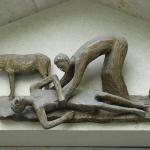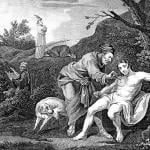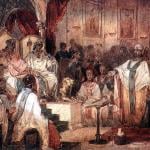 Yesterday I talked about St. Stephen of Hungary—but how did I forget to tell you THIS part of the story?!
Yesterday I talked about St. Stephen of Hungary—but how did I forget to tell you THIS part of the story?!
During his lifetime, good King Stephen, first Christian king of the Hungarians, had offered the Hungarian people to the Blessed Virgin Mary. As he lie on his deathbed—his right hand holding high the Holy Crown—Stephen prayed, asking Our Lady to be the Queen of the Hungarians.
As part of the investigation leading up to the canonization of St. Stephen, first Christian king of Hungary, his body was exhumed. While most of the body had decayed, his right hand and arm remained incorrupt.
Here’s where the story gets really odd: The incorrupt arm was cut up and divided among European royalty, but the “Holy Right,” Stephen’s right fist, was kept by the Hungarians and placed in the town of “Szent Jobb” (Holy Right), which was built in Transylvania specifically for the purpose of honoring Stephen’s hand. Later, when Szent Jobb (and all of Transylvania) was annexed by Romania, the Holy Right was transferred to the Basilica of King Saint Stephen in Budapest, where it is kept today.
On the Feast of St. Stephen (August 20) each year, the first King of Hungary is remembered and the Holy Right is carried in procession through the town.
* * * * *
So Why Do Catholics Venerate Relics?
Relics are one of the odd realities of Catholic piety. Many Protestants object to the idea of venerating relics of saints; isn’t this just petty superstition?
Actually, no.
First, a clarification: The Catholic Church does not ascribe any “magical power” to relics. There is nothing in the relic itself—whether a bone of the apostle Peter, or a piece of a garment, or water from Lourdes—that has any curative ability. Only God can cure. However, Catholics believe that relics may be a help, that God may work through a relic to heal the sick or work a miracle.
And just why does the Church make this claim? Because as in all things, the Church follows the Scriptures.
Remember, in the Book of Kings, that God worked a miracle, when touching the bones of Elisha brought a dead man to life:
“So Elisha died, and they buried him. Now bands of Moabites used to invade the land in the spring of the year. And as a man was being buried, lo, a marauding band was seen and the man was cast into the grave of Elisha; and as soon as the man touched the bones of Elisha, he revived, and stood on his feet” (2 Kgs. 13:20-21).
In another example from the New Testament (Matthew 9:20-22), the woman with the hemorrhage was cured by simply touching the hem of Christ’s garment.
In the Acts of the Apostles, the sick were healed when Peter’s shadow passed over them (Acts 5:14-16).
And do you remember the handkerchiefs or aprons which the apostle Paul had touched?
“And God did extraordinary miracles by the hands of Paul, so that handkerchiefs or aprons were carried away from his body to the sick, and diseases left them and the evil spirits came out of them” (Acts 19:11-12).
The evangelical preacher Billy Graham adopted Paul’s custom—by sending his supporters “prayer handkerchiefs” over which he had prayed.
So if you reject the idea of using relics in Christian prayer, then you really should reject all of these examples from Scripture, as well. In fact, you should wonder why in the world Mary Magdalen and the women should ever have sought to anoint the Body of Christ, after His death by crucifixion. Their respect for the body of a deceased person is no different from that of the people of Hungary, joyful in their prayerful respect for St. Stephen (and his Holy Right).










